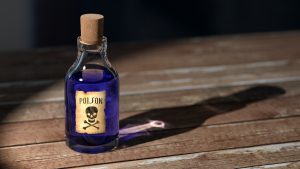
The Nightmare Down Chemistry Lane Continues… Using Isolated Compounds to Scare the Droppers Out of Essential Oils Lovers’ Hands!
My scientifically-induced trauma keeps resurfacing as studies continue to extrapolate isolated compounds found in essential oils to essential oils’ effects. Due to the misleading hype in recent headlines that used this logic to blame certain essential oils into shame, calling them potential endocrine disruptors, I’ve released a series to set the science straight.
One by one, I aim to defend the good name of individual victims that are being wrongly accused. I started with Ms. Clary sage oil, due to the sclareol-scare-all-hype. This essential oil was an excellent example that its actions cannot be based on isolating one constituent. Sclareol was reported to supposedly act similar to our own endogenous hormones based on its chemistry, but it doesn’t. Neither dose sage oil.
Next, I busted the myth that clary sage and fennel are “estrogenic” or act as estrogen mimickers once and for all by reporting on human trials. Any of the “hormonal effects” of these essential oils are related to their balancing properties, synergism of the oil, and the individual’s unique biochemistry.
Before I get into the unfounded claims of the estrogen activity of sage oil, I want to finish the general overview and “safety concerns” with it. Just as hormonal effects can’t be construed by one compound, neither can toxicity.
This story appears all too much like a sequel to the fennel-estrogole debate. Two compounds in sage oil, camphor and thujone, also been mistaken as equivalent to the essential oils. Warnings have been issued based on this compounds actions in petri dish and rodent studies and from cases of overdosage and resultant human responses.
Thujone
Rodent studies, and a fly study, have reported that there is concern for seizure activity with exposure to this constituent. (source, source, source, source, source, source) Yet similarly to fennel’s companion estragole, there’s evidence that mice, rodents, and human’s liver (in vitro) may detoxify thujone differently. (source, source) Furthermore, mode of delivery is often not comparable to proper usage in human beings. (More on this later)
I found one abstract that reported that eleven essential oils, including sage, may cause seizures in humans, but I was not able to get the full article. The abstract appeared to be more of a caution based on a survey and the content of ketones in these essential oils. (source)
If you want a thorough review of the outcomes and some of the trials done with thujone, toxnet will keep you busy for a few hours…or days, with its pages of reviews on animal studies and petri dishes. Just search the word “sage oil” on this website page using the nifty “CTRL and F”-button-click-trick and see if you can find a human clinical trial that reports on the actual essential oil causing seizures with proper dosage.
If you do, comment below…because I didn’t.

Camphor
Regarding camphor, there were several cases I found in the literature. The first two cases spew its danger and warn against in use. Below is the whole story.
In the first case, the father gave the child one teaspoon (equivalent to about 98 drops) of camphorated oil.
As a result, the child experienced seizures, was rushed to the hospital, and…
…recovered completely. *
(Please note, 1-2 drops are a typical serving of essential oils, this is an overdose.)
In the second case, the child ingested 20ml of the oil, given by her parent!!
That is more than a full bottle of an essential oil.
The child experienced seizures and needed emergency care.
Again, the child fully recovered.*
Please moms, dads, guardians, do not let your child swallow more than one bottle of an essential oil!
Three cases of seizures in children were reported with illegal imported camphor, which also appears to be related to overdosage issues (abstract). Again, no fatalities. *
*Please note that these cases were not regarding sage essential oil.
Due to the above, camphorated (cotton seed oil) was taken off the market in the United States, but it is still available in Canada as an over-the-counter.
WebMD recommends not taking camphor by mouth and using dilution on the skin.
According to the general guidelines I found online (source), one article (source) and a consensus statement in 2006, issues arise with camphor taken at 30mg/kg.
One study cites in 10% camphor oil, there is 500mg of camphor, in 5ml.
Let’s break that down:
- They state that 5ml could be toxic to a child, this is about 80-100 drops.
- Even if this is 20% and doubled as camphor, that would be 2.5ml, or about 40-50 drops.
If ANYONE thinks it’s OK to give their child 40-50 drops of essential oils, please review the resources for safety here.
Now that we’ve highlighted the isolated compounds and safety, let’s look at the evidence with the actual essential oil in Part II: The Oil Versus the Isolate.
Many blessings from my heart to yours!
This material is for information purposes only and is not intended to diagnose, treat, or prescribe for any illness. You should check with your doctor regarding implementing any new strategies into your wellness regime. These statements have not been evaluated by the FDA. (Affiliation link.)
Disclaimer: This information is applicable ONLY for therapeutic quality essential oils. This information DOES NOT apply to essential oils that have not been tested for purity and standardized constituents. There is no quality control in the United States, and oils labeled as “100% pure” need only to contain 5% of the actual oil. The rest of the bottle can be filled with fillers and sometimes toxic ingredients that can irritate the skin. The studies are not based solely on a specific brand of an essential oil, unless stated. Please read the full study for more information.
Thanks Pixabay and iStock purchases.



